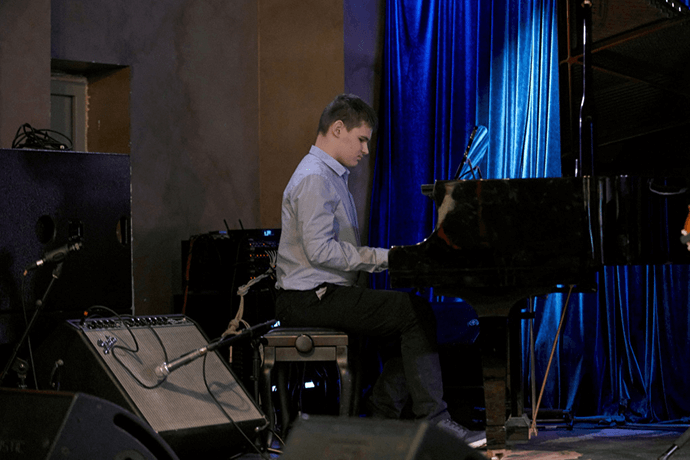How does improvisation training take place?
First, we need to determine the level of knowledge and skills of the student. As much as we would like to, a solid foundation in solfeggio is essential when teaching musical improvisation on the piano!
The process of improvisation is inextricably linked to the operation of such concepts as gamma, arpeggios, staccato and legato, rhythm and duration, intervals, semitones and much more!
Constant practice and technical development, performance preparations are also an integral part of learning to improvise on the piano. A lot of time is devoted to this in every lesson.
Practical mastery of various improvisation methods is necessary in order to be able to freely choose the right ways and methods of material development at the right moment, to mix them to create something special.
The more you practice, the better you will get at it. Moments of joint improvisation with the teacher are invaluable. It is they that give you a clear understanding of the theory and apply all the knowledge you have gained.
Instrument proficiency level
The doors of the Virtuosi Music School are open to all those who cannot imagine life without music. That is why we do not distinguish between our students and welcome everyone without exception, regardless of age, education and initial level of knowledge. The same applies to the opportunity to learn to improvise freely on the piano. Our experienced teachers will teach improvisation to both beginners and people who have been studying music for years. Who may need this skill:
“For many people, improvisation on the piano seems to be the ultimate art. It involves the ability to control the process of performing, with little or no reference to sheet music. It is an amazing experience when a piece of music is created by the improviser directly in the process of playing it.”
What techniques we teach
In our Virtuoso Music School improvisation classes, our teachers will provide insight into the following points to master this skill:
What techniques we teach
- Improvisation within one harmony scale in a certain, given tonality, as well as transitions (deviations and modulations) to other tonalities, organization of the tonal plan and enrichment of the harmonic grid
- Selection of accompaniment to the melody
- Working in different styles with their subsequent alternation - for example, improvising on the theme of a classical piece in jazz style, and then - vice versa
Melody
- Changing, varying an already prepared melody
- Composing a melodic line using a characteristic sound sequence (e.g., blues fret);
- Studying various embellishments - melismas: forshlags, trills, etc
- Mastering the texture of the melody - chord, “bend” the melodic line, changing in the process of playing the intervals that make up the phrase, as well as diversify the rhythm of the phrase
Rhythmic organization
Changes in the rhythmic pattern of a piece require the musician to have an impeccable sense of rhythm. To achieve the desired result in this method, it is recommended to use a metronome. Moreover, both the accompaniment and the main melody can be subjected to changes in rhythm. The chords accompanying the melody can be decomposed into arpeggios, or the accompaniment can be purely bass-melodic.
What is improvisation based on?
During the lessons the teachers of the Virtuosi Music School will explain in detail what improvisation is based on and what fundamental points should be considered in this process. More specifically, it will be possible to get an idea of:
- The main theme of the piece, an element important but not necessarily present in every improvisation. Let's just say that having an existing harmonic grid will make it much easier for the musician to improvise
- The need to give musical experimentation some form. This is done so that listeners do not get bored with endless variations and melodies played countless times
- Genre. Here is a really important point to decide on the genre of improvisation. It can be a children's song, a polka, a waltz, an opera aria - anything! But the narrative canvas created by the musician must necessarily correspond to the chosen genre and have its distinctive characteristics
Our recommendations for beginners
And lastly, we'd like to share some tips and tricks to help you comprehend and master improvisation.
- Don't be afraid to make mistakes. That's how your own style and special pitch are born in the process of trial and error. If you suddenly play the “wrong” note, just pretend that it was intended and continue to move on, trying to correct the situation by returning to the “right”
- Our teachers will tell you that a great way to develop yourself as an improviser is to record your playing on a tape recorder. This is a great help in raising the level - listening to just played fragments, the musician notices successful moments, developing and supplementing them in the future
- Improvise constantly, playing music in your head. Compose without fear of experimentation. Even a novice improviser can easily invent a really interesting combination if he or she does it consistently, regularly, and in the right mood
- Improve your technique. Continuously. Make practicing playing scales, arpeggios, learning new accents a daily ritual if possible. Grow in terms of performance skills. There is no way to improvise without it






